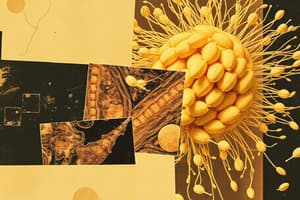Podcast
Questions and Answers
What is the primary role of glucose produced during photosynthesis in plants?
What is the primary role of glucose produced during photosynthesis in plants?
- To be transported as sucrose to roots for long-term storage.
- To be converted into cellulose for building cell walls.
- To be used in respiration to produce energy for the plant's metabolic processes. (correct)
- To be stored directly as starch within the chloroplasts.
Which of the following best describes the relationship between glucose and starch in plants?
Which of the following best describes the relationship between glucose and starch in plants?
- Glucose is a structural component of cell walls, while starch is used for immediate energy.
- Glucose is the building block of starch, serving as a stored form of energy. (correct)
- Both glucose and starch are directly utilized in respiration without interconversion.
- Starch is the building block of glucose, used for transport in the phloem.
Why do plants convert glucose into sucrose for transport rather than transporting glucose directly?
Why do plants convert glucose into sucrose for transport rather than transporting glucose directly?
- Sucrose is less reactive than glucose, making it more stable for long-distance transport. (correct)
- Sucrose is more soluble in water than glucose, facilitating faster movement.
- Sucrose provides structural support to the phloem tissue during transport.
- Sucrose is easier to metabolize than glucose once it reaches its destination.
A plant cell is actively growing and needs to reinforce its cell walls. Which of the following processes is most likely occurring?
A plant cell is actively growing and needs to reinforce its cell walls. Which of the following processes is most likely occurring?
During a period of prolonged darkness, a plant needs energy to survive. Which stored resource will the plant likely break down first to provide glucose for respiration?
During a period of prolonged darkness, a plant needs energy to survive. Which stored resource will the plant likely break down first to provide glucose for respiration?
Flashcards
Starch in plants
Starch in plants
Plants store energy as starch.
Cellulose function
Cellulose function
Cellulose is a structural component in plant cell walls, providing rigidity and support.
Glucose use in plants
Glucose use in plants
Glucose is used in respiration to produce energy (ATP) for the plant's metabolic processes.
Sucrose transport
Sucrose transport
Signup and view all the flashcards
Phloem function
Phloem function
Signup and view all the flashcards
Study Notes
- Plants utilize different carbohydrates for various crucial functions.
Starch
- Starch acts as a primary energy reserve in plants.
- It is a polysaccharide composed of numerous glucose molecules linked together.
- Plants synthesize starch during photosynthesis when there is an excess of glucose.
- Starch is stored in specialized organelles called amyloplasts, found in cells of leaves, stems, roots, and seeds.
- When energy is needed, starch is broken down into glucose molecules through hydrolysis.
- This glucose is then used in cellular respiration to produce ATP (adenosine triphosphate), the energy currency of the cell.
- Starch's insolubility is vital for storage; it doesn't affect the water potential of the cell.
- Two main types of starch polysaccharides exist: amylose and amylopectin.
- Amylose is a linear chain of glucose molecules linked by α-1,4-glycosidic bonds.
- Amylopectin is branched, with α-1,6-glycosidic bonds occurring at branch points along the α-1,4-linked glucose chain.
Cellulose
- Cellulose is a structural polysaccharide and a major component of plant cell walls.
- It is composed of long, unbranched chains of β-glucose molecules linked together by β-1,4-glycosidic bonds.
- These long chains of cellulose run parallel to each other and are cross-linked by hydrogen bonds.
- The hydrogen bonds between cellulose molecules provide high tensile strength to the cell wall.
- Cellulose provides rigidity and support to plant cells and the overall plant structure.
- Most organisms cannot digest cellulose because they lack the enzyme cellulase, which is needed to break the β-1,4-glycosidic bonds.
- Some microorganisms, such as bacteria and fungi, do produce cellulase, enabling them to break down cellulose.
- Herbivores rely on symbiotic microorganisms in their digestive tracts to digest cellulose.
Glucose
- Glucose is a simple sugar (monosaccharide) that serves as the primary source of energy for cells.
- It is produced during photosynthesis in plants.
- Glucose is used directly in cellular respiration to produce ATP.
- The chemical energy stored in glucose is released through a series of enzymatic reactions.
- This occurs in the cytoplasm and mitochondria.
- The ATP produced then powers various cellular processes.
- Glucose also serves as a building block for more complex carbohydrates like starch and cellulose.
- Plants regulate glucose levels to maintain energy balance and support growth and development.
Sucrose
- Sucrose is a disaccharide composed of one glucose molecule and one fructose molecule linked together.
- It is the primary form of sugar transported in the phloem.
- Phloem is the vascular tissue responsible for translocating nutrients from source tissues (e.g., leaves) to sink tissues (e.g., roots, fruits, developing leaves).
- Sucrose is soluble and relatively non-reactive, making it an ideal transport sugar.
- It does not get metabolized during transport.
- At the sink tissues, sucrose is either broken down into glucose and fructose for energy or converted into starch for storage.
- The transport of sucrose involves active transport mechanisms to load it into the phloem at the source and unload it at the sink.
- This process is essential for distributing energy and building blocks throughout the plant.
Studying That Suits You
Use AI to generate personalized quizzes and flashcards to suit your learning preferences.




